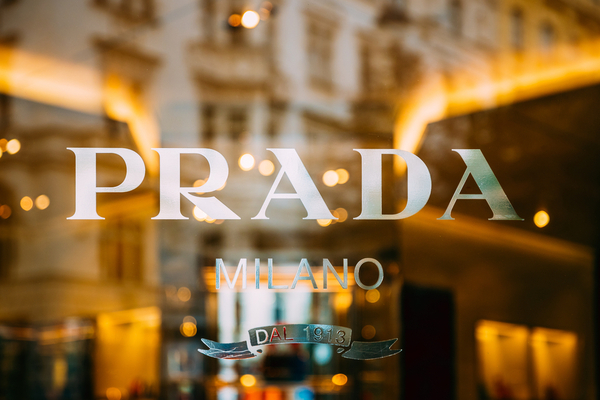Back in 2015, Prada’s co-CEO’s Miuccia Prada and Patrizio Bertelli announced that the storied fashion label would be ramping up its efforts to “go green.” Seven years later, it looks like their efforts at sustainability are succeeding.
According to the information published on their Prada Group website, between 2013 and 2014 the Prada Group allowed a 6% reduction in overall CO2 emissions, replaced a total of 3.800 fluorescent bulbs with LED lighting, continued the replacement of cooling and heating systems with next generation ones, improved the recycling process of its products and reduced the impact of its packaging, preferring recycled paper and eco-friendly materials.
“Prada Group’s sustainability strategy is the blueprint of a long process of growth and enhancement for the planet, people and culture and it is designed to further build up and reinforce this commitment with ambitious target,” so states their website. Some of their key tenets are mitigating the company’s impact on climate change, promoting inclusion and championing diversity, preserving ecosystems, increasing sustainability literacy, and embracing circular thinking. The Prada Group includes the original Prada label, founded by Miuccia Prada’s grandfather in 1913, Miu Miu, Church’s Marchesi 1824, Luna Rossa, and Car Shoe.
In 2019, they were the first luxury brand to sign a loan agreement tied to sustainability targets. The five year, 50 million Euro agreement allowed for interest rates to be adjusted annually according to how successful the fashion house was doing in meeting key targets around the sustainability of its products and operations. The loan focused on three specific objectives. The first condition related to the brand’s physical stores, stipulating that a certain number of them must be certified gold or platinum by the green-building rating system Leadership in Energy and Environmental Design (LEED), which takes into account the design of a building, its management, and the amount of resources it consumes or waste it produces. The second required Prada to increase the training hours of its employees, and the third reinforced the brand’s pledge to phase out the use of virgin nylon by 2021, shifting instead to ECONYL, a recyclable yarn upcycled from plastic waste.
Also in 2019, Prada announced that it was going fur-free, and also launched the Re-Nylon collection, consisting of bags made from the regenerated Econyl material. “This transaction demonstrates that sustainability is a key element for the development of the Prada Group, increasingly integrated into our strategy,” commented Alessandra Cozzani, Prada’s chief financial officer. In November 2021, Prada said it would use more low-impact materials in its products and packaging, and lower greenhouse gas emissions as part of a carbon-neutrality push. In February 2021, another sustainability-linked loan, arranged with UniCredit, raised 90 million euros. It’s linked to the regeneration and reconversion of production waste, and to boosting Prada’s share of self-produced energy.
In February of this year, Prada became the label with the highest number of LEED certified buildings in the luxury sector. The rating system was first implemented in the United States of America and later became the world’s most extensively used green building assessment system. The certification works on the basis of a credit awarding system. For assessment, the elements of sustainable development which are directly related to buildings are evaluated. Besides evaluating, it prepares a framework for efficient, healthy, carbon and cost-saving green buildings. The certification accepted across the globe is a symbol of sustainability, achievement, and leadership. The assessment system aims to create better buildings by reducing the anthropogenic impact of global climate change.
Prada makes use of the Arc technology platform to monitor, manage, and ameliorate the performance of its shops with regards to waste management, energy and water consumption, product shipping and people’s well-being. As a result of its progressive efforts, Prada was awarded 80 LEED certifications for its monobrand stores worldwide. Furthermore, Prada is targeting 300 certified stores by 2024.
Now, Lorenzo Bertelli, son of Patrizio and Miuccia, who joined Prada’s board of directors in 2021 and is next in line to be CEO, is a member of board-level committee focused on environmental and social sustainability issues. Bertelli is a champion of the Prada Group’s Sea Beyond, a program that aims to raise awareness about ocean preservation among secondary school students. The project is supported by revenue from the Prada Re-Nylon line of sustainable bags made from nylon yarn obtained by recycling discarded plastic collected from landfills and oceans. Since the end of 2021, Prada has converted all the production of virgin nylon into regenerated nylon.
Prada says its scientists are now trying to invent other eco-friendly materials, especially as a younger generation of buyers demand more sustainable products. But leather — a mainstay of Prada’s handbags, jackets and shoes — isn’t that easy to substitute. “Today, there is no solution in place for scaling back real leather,” said Bertelli. “There are fake leathers but that’s different. The culture is changing, but it will take time.”
—
Photo Credit: Grisha Bruev / Shutterstock.com
